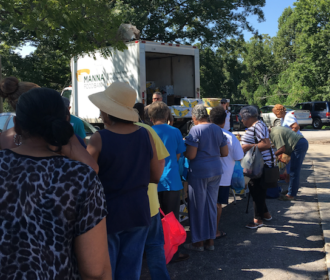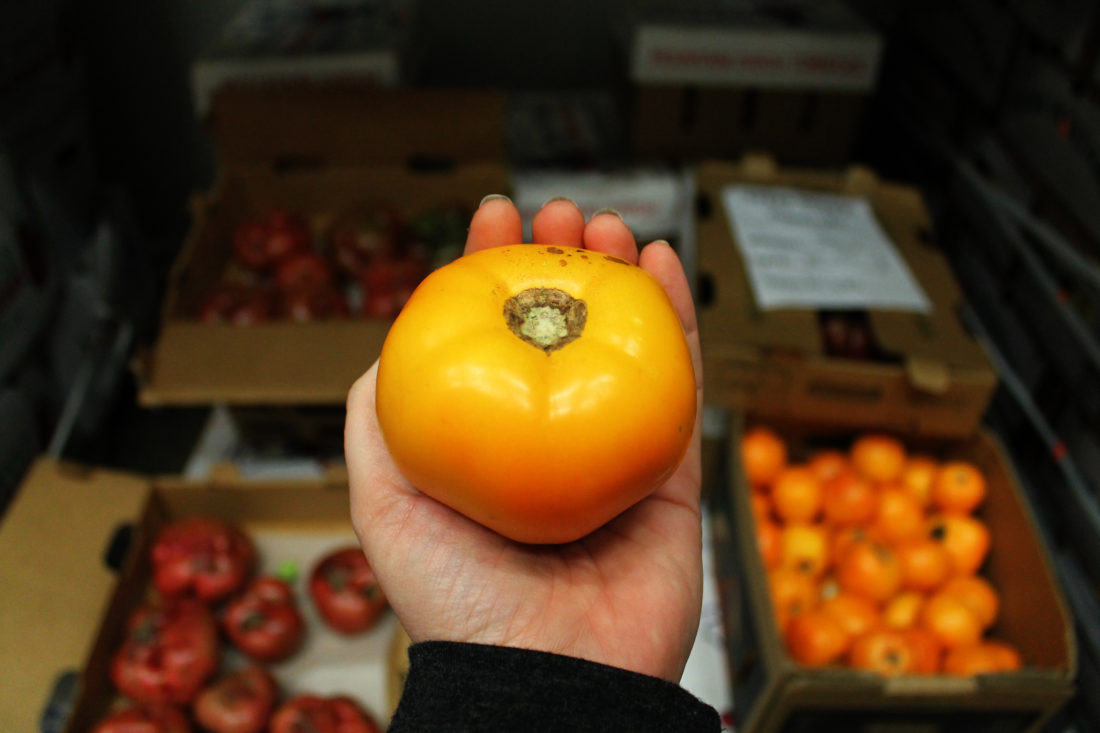For those unfamiliar with the terrain, it’s a bit of a trick to find Addie’s Chapel United Methodist Church. Although it’s really just a stone’s throw from Interstate 40 in Marion, the church feels remote, hidden along a twisting road in a community of small homes and trailers nestled against steep hillsides.
But on a recent late-summer afternoon, the church’s parking lot was a bustling hub of activity. Selected as the launch site for MANNA FoodBank’s brand-new Pop-Up Markets program, nearly 70 community members gathered near a line of folding tables beside a MANNA box truck. The neighbors — a mix of races, genders and ages, from elderly folks to young parents with babies and toddlers in tow — chatted while filling shopping bags with fresh, healthy and free grocery options. The tables offered everything from oranges, zucchini and potatoes to potted herb plants and protein-rich items like soup stocks and yogurt.
Although Addie’s Chapel isn’t one of MANNA’s official partner agencies, which must meet specific requirements and go through an application process, the Pop-Up Markets program permits any organization or individual in a community of need to team up with MANNA to host food distribution events. “It allows us to work a little outside the box and collaborate with new and different partners,” says agency relations manager Amy Haynes, who is coordinating the program.
The concept struck some West Marion residents as a great opportunity. “This is the central location for our community,” says Paula Avery, who lives near the church and is the executive director of the West Marion Community Forum, a group of residents who are working to create avenues for accessing much-needed resources for their neighborhood. “[Our pastor] is really passionate about doing a food pantry, so we thought, ‘Well, we’ll do this pop-up, maybe a couple of them, and see what happens.’”
The area surrounding Addie’s Chapel lacks a food pantry, yet it’s one of many pockets of deep need that MANNA has identified through recent research within its 16-county service area. Most state and federal statistics show that an average of one in four children and one in six adults in Western North Carolina are food-insecure. But the nonprofit’s data revealed small communities where the actual numbers for children were closer to eight or nine out of 10.
And those sectors of dire need aren’t limited to remote, rural corners of WNC. Many are hiding right under the nose of Asheville’s thriving food scene — a corner of the Oakley neighborhood, parts of Swannanoa and a community outside Candler, just to name a few.

When MANNA looked at those alarming metrics alongside a map of its partner agencies’ food pantry locations, a shocking realization dawned. “We identified communities across 16 counties where, not only do we have a food desert, but we also have a pantry desert,” says MANNA chief development officer Mary Nesbitt. “We felt, literally, a moral obligation to something about this.”
MANNA’s answer is an initiative called the Mobile Resource Center. A $170,000 gift from the Glass Foundation will fund the purchase of a new truck retrofitted with shelves and refrigeration units to create a food pantry on wheels that will be able to access underserved communities that lack their own pantries. Additionally, a portion of a recently announced grant from Blue Cross and Blue Shield of North Carolina will fund a new staff position for the planning and oversight of the Mobile Resource Center program.
Although plans for the truck are still in the works, Nesbitt says it will be designed like a mobile grocery store, with a center aisle lined with reach-in coolers and display shelves. “We won’t just have to dump out boxes on the lawn,” she says. “People will be able to walk inside and shop and select the items they want and need. Making it possible for clients to shop for their food versus handing out prepackaged boxes of food eliminates waste and is in keeping with out commitment to provide food with hope and dignity.”
The MRC will also collaborate with other agencies in the communities it visits to provide a sort of one-stop shop of services, such as emergency utilities assistance, literacy, transportation, senior services and more. “So while they’re in their neighborhood, folks can solve more than one challenge while they’re there,” says Nesbitt.
MANNA envisions running the truck four to five days per week, perhaps including Saturdays to help accommodate the hectic schedules of the working poor who often hold down multiple jobs to make ends meet. During the nine months to one year that it will take to retrofit the truck, Nesbitt says, MANNA will be using its Pop-Up Markets program to support and inform the mobile pantry effort.
“While we’re out there in those communities where we don’t have partner pantries and people don’t have access to the food they need, we will be building relationships and laying groundwork for the places we’ll be able to take our Mobile Resource Center,” Nesbitt explains.
Ultimately, the MRC and Pop-Up Markets programs are the culmination of step-by-step work MANNA’s been doing for almost five years to build capacity and increase its ability to provide fresh, healthy foods to those who need it. The overarching goal, says Nesbitt, is to address health inequities among the poor.
“The health disparities that are faced by the most vulnerable populations are astounding,” she says. “Hypertension, diabetes, people choosing to not take medication to manage their diabetes because they don’t have enough food to eat or don’t have access to the right food to manage their heart disease. We’ve made a commitment that people’s health outcomes should not be different just because they’re economically disadvantaged.”
Details about MANNA’s programming and partner agencies can be found at mannafoodbank.org. For details on hosting a MANNA Pop-Up Market, contact Amy Haynes at ahaynes@mannafoodbank.org.




Before you comment
The comments section is here to provide a platform for civil dialogue on the issues we face together as a local community. Xpress is committed to offering this platform for all voices, but when the tone of the discussion gets nasty or strays off topic, we believe many people choose not to participate. Xpress editors are determined to moderate comments to ensure a constructive interchange is maintained. All comments judged not to be in keeping with the spirit of civil discourse will be removed and repeat violators will be banned. See here for our terms of service. Thank you for being part of this effort to promote respectful discussion.